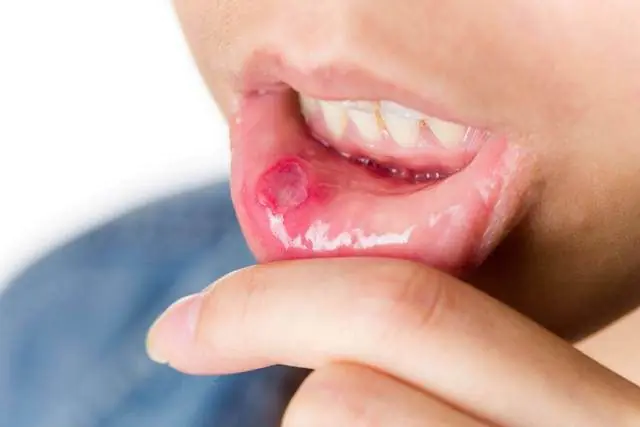
What is stomatitis, why does it occur in children? Main symptoms and diagnostic methods. Treatment of illness with drugs and folk methods, useful tips.
The content of the article:- Causes of stomatitis in a child
- Main symptoms
- Diagnostic methods
- Treatment options
- Medicines
- Folk remedies
- Useful tips
Stomatitis in children is a lesion of the oral mucosa of an inflammatory nature, which is caused by many factors. The pathology is accompanied by severe discomfort, and therefore requires proper treatment and care. In some cases it is a contagious disease.
Causes of stomatitis in a child
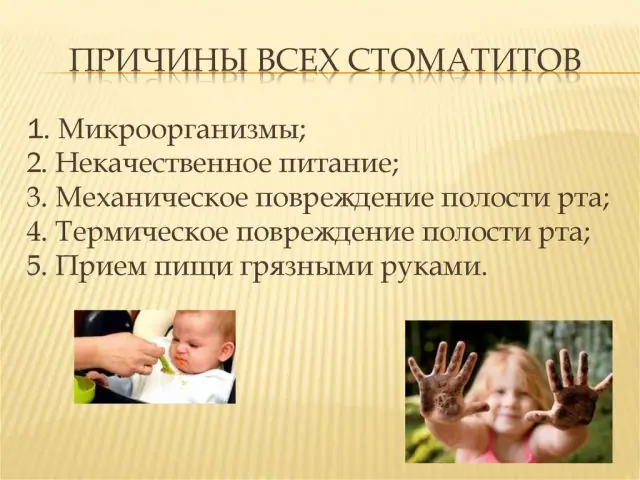
The main causes of stomatitis in children
Stomatitis in children is a common inflammatory pathology. It occurs with equal frequency in infants and older children. The disease is not dangerous, but can lead to various unpleasant consequences for the child. To avoid this, stomatitis should be diagnosed in time and consult a doctor, who will prescribe complex therapy to directly influence the cause of the disease and maximize the relief of the baby’s condition.
Inflammation of the oral mucosa in childhood can develop due to the influence of many factors. The main causes of stomatitis in children are as follows:
- Viruses. Approximately 80% of cases of this disease are caused by the herpes virus type 1. Children aged 3 to 7 years are most sensitive to it. Viral stomatitis is especially difficult. It is accompanied by severe pain, fever and associated local symptoms (severe weakness and muscle pain).
- Bacteria. The most common bacterial pathogens of the disease are staphylococci and streptococci. They cause the formation of ulcers and crusts not only on the oral mucosa, but also on the outer surface of the lips. Such injuries often fester. Bacterial stomatitis is most often a complication of diseases such as caries, sore throat, pneumonia. However, microorganisms can also enter the mouth if the rules of personal hygiene are neglected in older children, for example, with irregular or improper brushing of teeth.
- Fungi. Babies under 1 year of age, especially those who are breastfed, often develop stomatitis, which is caused by a fungus of the genus Candida. People call it thrush. Most often, fungal stomatitis in a child’s mouth is associated with the mother’s failure to comply with personal hygiene, improper breast care and weakened immunity of the baby.
- Allergy. It can develop as a result of an allergic reaction to food, household dust, animal hair, pollen. As a result, ulcerative inflammation of the oral cavity occurs, which, unlike other types, is accompanied by severe swelling and itching.
- Immunity disorders. In childhood, protecting the body from foreign substances is very important. When the immune system is weak or excessively active (autoimmune pathologies), aphthous stomatitis can develop. It occurs due to the body's inability to control the entry of pathogens into the oral cavity.
- Traumatization. A small child, especially during teething, often puts foreign objects in his mouth. If he is not careful, he may get hurt. In older children, cheek biting and food burns occur. The result is a wound that quickly becomes infected and turns into an ulcer.
- Medicines. Certain drugs can cause drug-induced stomatitis in children. Some antibiotics, as well as chemotherapy drugs that are used in the treatment of cancer, have such side effects.
- Hypovitaminosis. Vitamin A is responsible for the regeneration of the skin and mucous membranes, so if it is deficient, stomatitis can occur. Vitamin B12 is also important. In case of its deficiency, characteristic anemia develops, the main manifestations of which are stomatitis and “lacquered” tongue.
The main symptoms of stomatitis in children
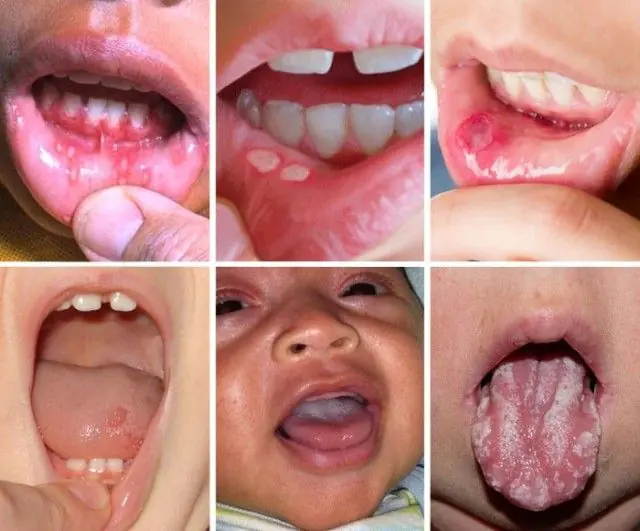
The photo shows what stomatitis looks like in children
The manifestations of stomatitis largely depend on the cause that causes it. However, there are a number of common signs that are inherent in almost all types of this pathology.
The main symptoms of stomatitis in children:
- The appearance of ulcers. The lesion is a defect in the oral mucosa with a diameter of up to 5 mm. There is a white-yellow bottom, limited by clear reddish edges. The ulcers may be on the inside of the cheeks, lips, palate, tongue, gums or tonsils.
- Swelling and redness of the mucous membrane. They are definitely present around ulcerative defects, because there is an inflammatory process. Swelling and redness are especially pronounced with allergies.
- Bad breath. This symptom of stomatitis in children is provoked by the proliferation and decay of pathogenic microorganisms that caused the development of stomatitis. Most often it is observed in bacterial and viral processes.
- "Geographical" language. With stomatitis, often aphthous, a white coating appears on the tongue. Against this background, the baby begins to be bothered by a burning sensation. Then smooth pink-red spots appear on the tongue, limited by a clear outline and covered with small bubbles. This drawing resembles a geographical map, which is why the corresponding name was given.
- Changing your child's behavior. Older children can clearly articulate their complaints, indicating pain, while eating and talking. Babies begin to refuse the breast or formula in a bottle, often cry, become irritable, and sleep poorly. All this indicates an inflammatory process in the child’s body.
- Temperature increase. It is observed with stomatitis in a child’s mouth of viral and bacterial etiology. The temperature rises to subfebrile values (37-38OC) and is accompanied by a deterioration in the general condition of the baby.
- Lymphadenitis. From the oral cavity, the infection spreads through the lymphatic vessels to nearby lymph nodes, as a result of which they become inflamed, enlarged and painful to the touch. With stomatitis, the submandibular and mental lymph nodes are most often affected.
Herpetic stomatitis is the most severe in children. Its causative agent is present in almost every person, but manifests itself only when the immune system is weakened. In this case, small grouped bubbles filled with a cloudy liquid appear in the mouth, causing very severe pain. Blisters can also form on the lips and in the nasal cavity. After some time, they burst, and painful erosions remain in their place. In this case, the child’s general well-being is disrupted and the temperature necessarily rises.
Fungal stomatitis in children or thrush is the mildest form of the disease. It is characterized by the appearance not of ulcers, but of areas of white cheesy plaque in the oral cavity, which are easily and painlessly removed without leaving behind erosions. Thrush often develops after long-term treatment with antibiotics, which leads to suppression of local immunity and activation of an opportunistic fungus.
Methods for diagnosing stomatitis in children
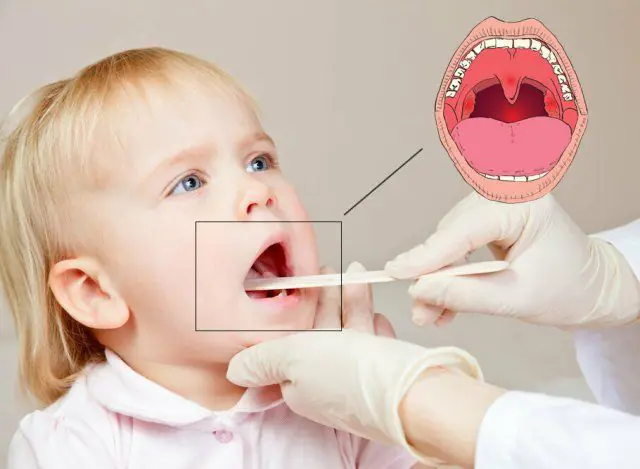
To make a correct diagnosis, you need to consult a pediatrician, or better yet, a pediatric dentist. The doctor will examine your mouth. If there is inflammation, you can see ulcers, blisters, plaques and a “geographical” tongue there. Scraping is also performed from areas of inflammation to identify the causative agent of stomatitis in children.
If inflammation in the mouth often recurs or does not respond to treatment for a long time, in order to exclude pathologies of the immune system and allergies, a general blood test is taken and an immunogram is performed. After the examination, the doctor will prescribe appropriate treatment.
Methods for treating stomatitis in children
The treatment regimen for the disease includes the use of medications and folk remedies. Let's look at each of the methods in more detail.
Medicines for stomatitis in children
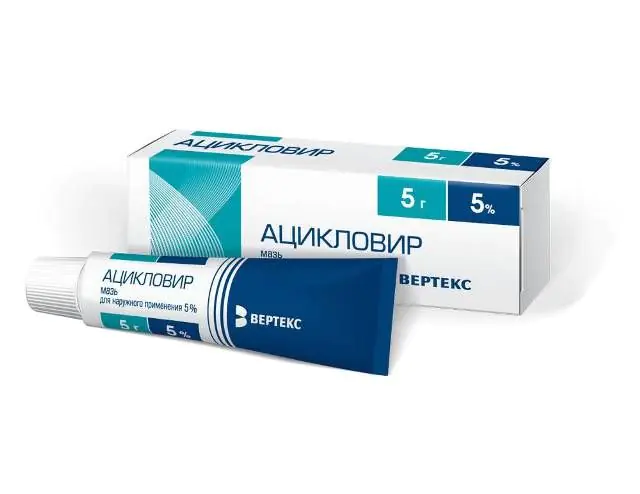
In the photo Acyclovir cream 5% for herpetic stomatitis in children
To alleviate the child’s condition during illness, it is necessary to reduce pain and inflammation, as well as act directly on the cause that led to stomatitis. In this regard, therapy should be comprehensive, i.e. not consist of one drug.
How to treat stomatitis in children:
- Hexoral spray 0.1%. It has a good antibacterial and antifungal effect, relieves pain and accelerates the healing of wounds in the mouth. It can be sprayed directly onto areas of stomatitis or rinsed with an undiluted solution in the mouth, but no more than 3 times a day. The price of Hexoral is from 218 rubles in Russia (from 107 hryvnia in Ukraine) for 40 ml.
- Stomatidine solution 0.1%. An analogue of Hexoral, the active substance is the same, but it has a more pronounced analgesic effect. The solution is used to rinse the mouth 2-3 times a day for 30 seconds. The price of the drug is from 230 rubles in Russia (from 122 hryvnia in Ukraine) for 200 ml.
- Acyclovir cream 5%. It is prescribed only for herpetic stomatitis in a child’s mouth. Has a pronounced antiviral effect. The cream should be applied to areas of herpetic rashes using a cotton swab 5 times a day (every 4 hours). The duration of treatment should be agreed with the attending physician. The price of Acyclovir is from 33 rubles in Russia (from 45 hryvnia in Ukraine) for 5 g.
- Nystatin ointment. An antibacterial agent that has a pronounced antifungal effect and is effective for candidal stomatitis. The ointment must be applied pointwise to the affected areas 1-2 times a day. The price of the drug for stomatitis in children is from 42 rubles in Russia (from 20 hryvnia in Ukraine) for 15 g.
- Fenistil drops. An antiallergic drug that relieves swelling and itching in the area of stomatitis. It should not be given to a child under 1 month of age. For older children, the daily dose is 2 drops per 1 kg of body weight. The price of Fenistil is from 294 rubles in Russia (from 155 hryvnia in Ukraine) for 20 ml.
For severe concomitant diseases, such as tonsillitis and pneumonia, treatment of stomatitis in children includes systemic antibacterial therapy, which is prescribed exclusively by a doctor.
Folk remedies against stomatitis in children

Alternative treatment of stomatitis in children at home is no less effective than medication.
Let's consider the most effective folk remedies:
- Baking soda. It is necessary to dilute 2 tsp. funds for a glass of warm water. By moistening a cotton pad or swab in the resulting solution, you can spot treat the affected area 4-5 times a day. Baking soda helps especially well with thrush.
- Herbal infusion. To prepare a folk remedy for stomatitis in children, you need to mix 1 tbsp. l. dry collection of calendula, chamomile, sage, yarrow and oak bark. They are poured with a glass of hot water and left for 20 minutes. This infusion can be used for spot treatments and rinsing of the entire oral cavity several times a day.
- Kalanchoe juice. It has a powerful bactericidal effect against stomatitis in a child’s mouth, so it should be applied directly to the ulcers 3 times a day.
- Onion peel decoction. It is necessary to pour 5 tbsp. l. husks with 2 glasses of water, boil and leave for 8 hours. Onion broth is used to rinse the mouth.
- Freshly squeezed carrot juice. Must be diluted with water and used as a rinse solution. Carrot juice accelerates the healing of ulcers.
Useful tips for treating stomatitis in children
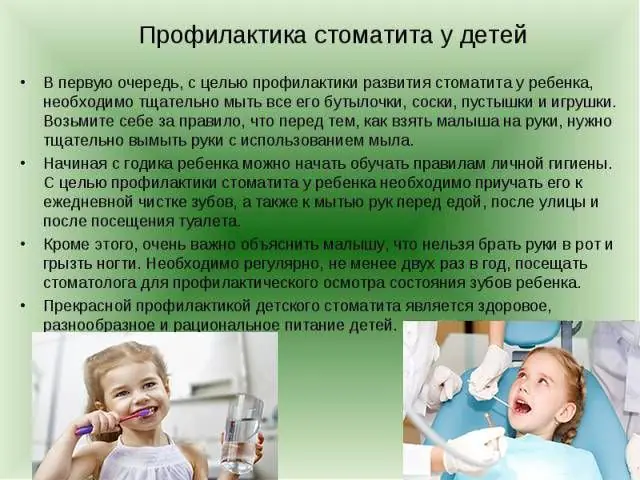
Regardless of what caused stomatitis in a child, there are several rules that parents of a sick child must follow.
General principles of treatment of stomatitis in children:
- Separate dishes. This is very important because the infection is transmitted in this way. The child should be given his own plate, spoon, fork, cup and boil them after each use.
- Personal towel. Stomatitis, and especially herpetic stomatitis, can be contracted through household items. To avoid this, the baby should be given his own towel.
- Gentle food. A patient with stomatitis should eat warm (not hot or cold), well-chopped, not spicy and not too salty food. Otherwise, the mucous membrane will be constantly irritated and injured.
- Regular oral care. Despite the inflammatory process, if the child already has teeth, they need to be brushed twice a day, only more carefully. Infants need to treat the oral cavity with antiseptic solutions.
How to treat stomatitis in children’s mouths - watch the video:
Stomatitis in a child is an unpleasant problem that causes a lot of inconvenience. However, with timely initiation and properly selected treatment, you can quickly get rid of it.



